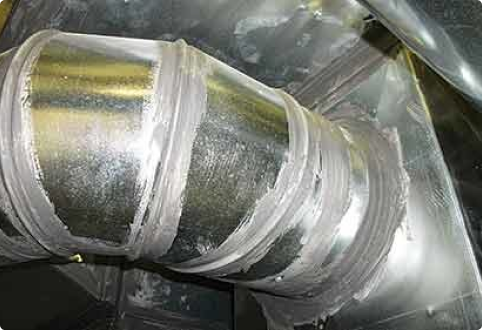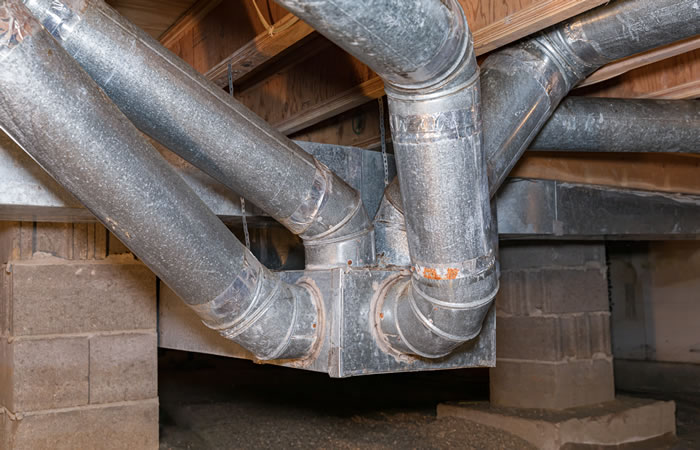A duct seal is a supercharged adhesive that plugs up air leaks in ductwork. This solution helps keep heated or cooled air from escaping. It cuts energy waste and helps lower your utility costs.
Who applies this material? Skilled HVAC technicians. They use mastic sealants, foil tape, and HVAC duct sealant aerosol. These tools let them seal even the smallest leaks with precision.
Filterbuy HVAC Solutions provides expert duct sealing and AC services across Southeast Florida. They are known for clear pricing, skilled technicians and reliable support.
Top Takeaways
- A duct seal stops leaks in ducts to allow better air circulation.
- Sealant choice varies with the leak’s size and its location in the ductwork.
- The process starts with leak detection using specialized tools.
- Materials include mastic, foil tape, and HVAC duct sealant aerosol.
- Inside duct sealing is best left to skilled and trained technicians.
Duct Seal Basics
Duct seal is not just one product. It includes different materials. Mastic sealants are durable and water-resistant. Foil tape holds strong under high heat. Aerosol-based sealants can reach hidden spots.
Sometimes professionals use aeroseal duct sealing cost–friendly methods. These involve sealing ductwork from the inside with advanced tools.
There are also special uses like duct seal electrical and duct seal for electrical conduit. These are used to protect electrical connections and keep the system safe.
A proper duct seal improves airflow. It cuts wasted energy. It blocks dust and allergens from entering your home. A sealed duct system lowers bills. It also extends the life of your HVAC system.
Protecting Your Home with Proper Duct Sealing
When air leaks through ducts, your HVAC system works harder. This leads to higher bills. It also causes extra wear on the system.
Sealing ductwork from the inside prevents these problems. It also blocks allergens and dust. This stops pollutants from spreading through your home.
“After Filterbuy HVAC Solutions sealed our ducts, our home cooled faster. The AC ran less often. The team explained everything up front. The guaranteed pricing gave us peace of mind. We’ve already seen lower bills.” – Sarah M., Boca Raton, FL
This shows how sealing ducts not only improves comfort but also delivers real savings.
Step-by-Step Duct Seal Application
- Inspection – Technicians inspect ducts with smoke pencils or pressure monitors. These tools help them find leaks.
- Material Selection – They choose the right sealant. Mastic is used for bigger gaps. Foil tape is used for hot areas. HVAC duct sealant aerosol is used for tight spaces.
- Application – Sealant is applied. Then it is reinforced with foil or fabric tape.
- Final Check – A final inspection makes sure no air is escaping.
This process requires training. It is not just about spreading glue. The right tools and techniques are needed to make sure the seal lasts.
Expert Techniques for Duct Sealing
Certified technicians, like those at Filterbuy HVAC Solutions, use advanced tools. Spray systems and caulking guns help them get precise coverage. Their expertise guarantees a reliable and lasting seal.
The installation of HVAC air purifiers and duct sealing requires certified experts. Unqualified work can hurt performance. It can also damage your system.
At Filterbuy HVAC Solutions, licensed experts follow safety codes. They use the proper tools. They also make sure your system is set up the right way.
Statistics on Duct Sealing
- The U.S. Department of Energy says sealing and insulating ducts improves comfort and efficiency.
- The EPA reports that leaky ducts can pull in fumes, dust, and insulation particles. These can make asthma and allergy problems worse.
- The EPA also says leaky ducts and poor insulation can waste 20% or more of a home’s heating and cooling energy.
These facts prove duct sealing does more than cut costs. It also protects health and improves air quality.
Conclusion: Why Duct Seal Matters
Duct seal is more than an adhesive. It is the key to lower bills, cleaner air, and a longer-lasting HVAC system.
Whether it’s sealing ductwork from the inside, using aerosol methods, or applying duct seal for electrical conduit, the right technique makes all the difference.
Filterbuy HVAC Solutions provides expert duct sealing with upfront pricing, strong warranties, and 24-hour support. As a family-owned company, they know the Florida climate. They also know how to give lasting comfort to local homes.
Why Choose Filterbuy HVAC Solutions for Duct Sealing?
Filterbuy HVAC Solutions believes in transparency and honesty. That’s why they offer guaranteed pricing with no hidden fees. Quotes are promises that do not change on service day.
Homeowners also benefit from:
- Better airflow and efficiency.
- Lower utility bills.
- Price matching with any reputable quote.
- 0% financing and $0 down for new installs.
- A 10-year warranty from Aeroseal.
- A 1-year labor warranty.
- 24-hour support every day of the week.
Find out more about duct seal and how technicians use it. Visit Filterbuy.com for details and expert advice.
Frequently Asked Questions
How long does a duct seal last?
The lifespan depends on the sealant quality and how it’s applied. Poor work or cheap materials can crack or peel. When done correctly with good materials, duct seal compound lasts for many years.
What is the cost of duct sealing?
Duct sealing cost changes based on home size, duct complexity and sealing methods. Most jobs range from $300 to $500. Large homes or complex systems may run over $1,000.
Is duct sealing worth it?
Yes. A professional inspection checks air leaks and insulation problems. Even small leaks hurt performance and raise bills. Sealing ducts improves efficiency, comfort and energy savings.
Does duct seal harden?
Some products stay soft and moldable, while others harden more. Many keep a little flexibility so they can move with the ducts without breaking. Duct seal putty is one example that stays pliable.
What is the purpose of duct seal?
It prevents air leaks, lowers energy use and improves comfort. Sealed ducts make your HVAC system work less and save money. If you’re wondering what is duct seal, it’s a material that keeps conditioned air inside your ducts instead of leaking out.
Can I seal ducts myself?
Yes, but it takes care. You can use duct sealing tape, HVAC sealant putty, or mastic. DIY can help, but sealing AC ducts fully is best left to trained pros.
Can duct seal be removed?
Yes. Some types harden and need gentle scraping. Others, like electrical duct sealant, stay flexible and pull off more easily. Take your time to avoid damaging the ductwork.
Will duct seal stop water?
Yes, if the sealant is moisture resistant. A good seal blocks water, which prevents mold and system damage. Many products, like duct seal putty, are designed with this in mind.
What is duct sealing?
If you’re asking what duct sealing is, it’s the process of closing gaps and leaks in ductwork. Pros use mastic, foil tape, or aerosol sprays to seal ac ducts. These methods cut energy waste and boost indoor air quality.
How often should ducts be replaced?
There’s no set timeline. Watch for higher energy bills or weaker airflow. These signs may mean leaks or damage. Replacement is only needed if repairs can’t restore performance.
Is duct seal reusable?
It depends on the type. Some harden and can’t be reused. Others, like soft HVAC sealant putty, may be reusable if removed carefully and kept in good condition.
What are the requirements for duct sealing?
Cover all seams, joints, and visible holes with sealant. Pay attention to vents and registers, since leaks often happen there. Learning how to use duct seal properly helps keep your system efficient.







